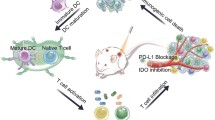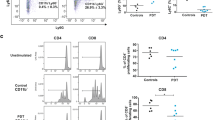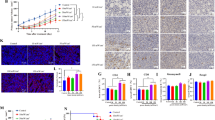Abstract
Photodynamic therapy (PDT) is an emerging clinical treatment that is expected to become an important adjuvant strategy for the immunotherapeutic cancer treatment. Recently, numerous works have reported combination strategies. However, clinical data showed that the anti-tumor immune response of PDT was not lasting though existing. The immune activation effect will eventually turn to immunosuppressive effect and get aggravated at the late stage post-PDT. So far, the mechanism is still unclear, which limits the design of specific correction strategies and further development of PDT. Several lines of evidence suggest a role for TGF-β1 in the immunosuppression associated with PDT. Herein, this study systematically illustrated the dynamic changes of immune states post-PDT within the tumor microenvironment. The results clearly demonstrated that high-light-dose PDT, as a therapeutic dose, induced early immune activation followed by late immunosuppression, which was mediated by the activated TGF-β1 upregulation. Then, the mechanism of PDT-induced TGF-β1 accumulation and immunosuppression was elucidated, including the ROS/TGF-β1/MMP-9 positive feedback loop and CD44-mediated local amplification, which was further confirmed by spatial transcriptomics, as well as by the extensive immune inhibitory effect of local high concentration of TGF-β1. Finally, a TGF-β blockade treatment strategy was presented as a promising combinational strategy to reverse high-light-dose PDT-associated immunosuppression. The results of this study provide new insights for the biology mechanism and smart improvement approaches to enhance tumor photodynamic immunotherapy.







Similar content being viewed by others
Data availability
All the data supporting the findings of this study are available within the article and its Supplementary Information files and from the corresponding authors upon reasonable request.
References
Gunaydin G, Gedik ME, Ayan S (2021) Photodynamic therapy for the treatment and diagnosis of cancer–a review of the current clinical status. Front Chem 9:686303
Cramer GM, Moon EK, Cengel KA, Busch TM (2020) Photodynamic therapy and immune checkpoint blockade(dagger). Photochem Photobiol 96(5):954–961
Pham TC, Nguyen V, Choi Y, Lee S, Yoon J (2021) Recent strategies to develop innovative photosensitizers for enhanced photodynamic therapy. Chem Rev 121(21):13454–13619
Han L, Wang Y, Huang X, Liu F, Ma C, Feng F, Zhang J, Liu W, Qu W, Pang H, Xue J (2020) Specific-oxygen-supply functionalized core-shell nanoparticles for smart mutual-promotion between photodynamic therapy and gambogic acid-induced chemotherapy. Biomaterials 257:120228
Guo J, Feng K, Wu W, Ruan Y, Liu H, Han X, Shao G, Sun X (2021) Smart (131) I-labeled self-illuminating photosensitizers for deep tumor therapy. Angew Chem Int Ed Engl 60(40):21884–21889
Beltran HI, Yu Y, Ossendorp F, Korbelik M, Oliveira S (2020) Preclinical and clinical evidence of immune responses triggered in oncologic photodynamic therapy: clinical recommendations. J Clin Med 9(2):333
Song R, Li T, Ye J, Sun F, Hou B, Saeed M, Gao J, Wang Y, Zhu Q, Xu Z, Yu H (2021) Acidity-activatable dynamic nanoparticles boosting ferroptotic cell death for immunotherapy of cancer. Adv Mater 33(31):2101155
Zhang Y, Liao Y, Tang Q, Lin J, Huang P (2021) Biomimetic nanoemulsion for synergistic photodynamic-immunotherapy against hypoxic breast tumor. Angew Chem Int Ed 60(19):10647–10653
Xu X, Deng G, Sun Z, Luo Y, Liu J, Yu X, Zhao Y, Gong P, Liu G, Zhang P, Pan F, Cai L, Tang BZ (2021) A biomimetic aggregation-induced emission photosensitizer with antigen-presenting and hitchhiking function for lipid droplet targeted photodynamic immunotherapy. Adv Mater 33(33):2102322
Reginato E, Lindenmann J, Langner C, Schweintzger N, Bambach I, Smolle-Juttner F, Wolf P (2014) Photodynamic therapy downregulates the function of regulatory T cells in patients with esophageal squamous cell carcinoma. Photochem Photobiol Sci 13(9):1281–1289
Pellegrini C, Orlandi A, Costanza G, Di Stefani A, Piccioni A, Di Cesare A, Chiricozzi A, Ferlosio A, Peris K, Fargnoli MC (2017) Expression of IL-23/Th17-related cytokines in basal cell carcinoma and in the response to medical treatments. PLoS ONE 12(8):e183415
Korbelik M, Hamblin MR (2015) The impact of macrophage-cancer cell interaction on the efficacy of photodynamic therapy. Photochem Photobiol Sci 14(8):1403–1409
Thanos SM, Halliday GM, Damian DL (2012) Nicotinamide reduces photodynamic therapy-induced immunosuppression in humans. Br J Dermatol 167(3):631–636
Matthews YJ, Damian DL (2010) Topical photodynamic therapy is immunosuppressive in humans. Br J Dermatol 162(3):637–641
Jackson CM, Choi J, Lim M (2019) Mechanisms of immunotherapy resistance: lessons from glioblastoma. Nat Immunol 20(9):1100–1109
Larson C, Oronsky B, Carter CA, Oronsky A, Knox SJ, Sher D, Reid TR (2020) TGF-beta: a master immune regulator. Expert Opin Ther Targets 24(5):427–438
Tauriello D, Sancho E, Batlle E (2022) Overcoming TGFbeta-mediated immune evasion in cancer. Nat Rev Cancer 22(1):25–44
Korbelik M (2006) PDT-associated host response and its role in the therapy outcome. Lasers Surg Med 38(5):500–508
Yang T, Tan Y, Zhang W, Yang W, Luo J, Chen L, Liu H, Yang G, Lei X (2020) Effects of ALA-PDT on the healing of mouse skin wounds infected with pseudomonas aeruginosa and its related mechanisms. Front Cell Dev Biol 8:585132
Chen J, Luo J, Tan Y, Wang M, Liu Z, Yang T, Lei X (2019) Effects of low-dose ALA-PDT on fibroblast photoaging induced by UVA irradiation and the underlying mechanisms. Photodiagn Photodyn Ther 27:79–84
Wang P, Han J, Wei M, Xu Y, Zhang G, Zhang H, Shi L, Liu X, Hamblin MR, Wang X (2018) Remodeling of dermal collagen in photoaged skin using low-dose 5-aminolevulinic acid photodynamic therapy occurs via the transforming growth factor-beta pathway. J Biophotonics 11(6):e201700357
Citrin DE (2017) Recent developments in radiotherapy. N Engl J Med 377(11):1065–1075
Vanpouille-Box C, Diamond JM, Pilones KA, Zavadil J, Babb JS, Formenti SC, Barcellos-Hoff MH, Demaria S (2015) TGFbeta Is a master regulator of radiation therapy-induced antitumor immunity. Cancer Res 75(11):2232–2242
Xiaojie W, Banda J, Qi H, Chang AK, Bwalya C, Chao L, Li X (2022) Scarless wound healing: current insights from the perspectives of TGF-beta, KGF-1, and KGF-2. Cytokine Growth Factor Rev 66:26–37
Sanjabi S, Oh SA, Li MO (2017) Regulation of the immune response by TGF-β: from conception to autoimmunity and infection. Cold Spring Harb Perspect Biol 9(6):a22236
Guidolin K, Ding L, Yan H, Englesakis HM, Chadi S, Quereshy F, Zheng G (2022) Photodynamic therapy for colorectal cancer: a systematic review of clinical research. Surg Innov 29(6):788–803
Soundararajan R, Fradette JJ, Konen JM, Moulder S, Zhang X, Gibbons DL, Varadarajan N, Wistuba II, Tripathy D, Bernatchez C, Byers LA, Chang JT, Contreras A, Lim B, Parra ER, Roarty EB, Wang J, Yang F, Barton M, Rosen JM, Mani SA (2019) Targeting the interplay between epithelial-to-mesenchymal-transition and the immune system for effective immunotherapy. Cancers 11(5):714
Pena-Romero AC, Orenes-Pinero E (2022) Dual effect of immune cells within tumour microenvironment: pro- and anti-tumour effects and their triggers. Cancers 14(7):1681
Hwang D, Ramsey JD, Makita N, Sachse C, Jordan R, Sokolsky-Papkov M, Kabanov AV (2019) Novel poly(2-oxazoline) block copolymer with aromatic heterocyclic side chains as a drug delivery platform. J Control Release 307:261–271
Vitale I, Manic G, Coussens LM, Kroemer G, Galluzzi L (2019) Macrophages and metabolism in the tumor microenvironment. Cell Metab 30(1):36–50
Khatua S, Simal-Gandara J, Acharya K (2022) Understanding immune-modulatory efficacy in vitro. Chem Biol Interact 352:109776
Hutas G, Bajnok E, Gal I, Finnegan A, Glant TT, Mikecz K (2008) CD44-specific antibody treatment and CD44 deficiency exert distinct effects on leukocyte recruitment in experimental arthritis. Blood 112(13):4999–5006
Cabrita R, Lauss M, Sanna A, Donia M, Skaarup Larsen M, Mitra S, Johansson I, Phung B, Harbst K, Vallon-Christersson J, van Schoiack A, Lövgren K, Warren S, Jirström K, Olsson H, Pietras K, Ingvar C, Isaksson K, Schadendorf D, Schmidt H, Bastholt L, Carneiro A, Wargo JA, Svane IM, Jönsson G (2020) Tertiary lymphoid structures improve immunotherapy and survival in melanoma. Nature 577(7791):561–565
Hao Y, Baker D, Ten Dijke P (2019) TGF-β-mediated epithelial-mesenchymal transition and cancer metastasis. Int J Mol Sci 20(11):2767
Xu J, Lamouille S, Derynck R (2009) TGF-beta-induced epithelial to mesenchymal transition. Cell Res 19(2):156–172
Li W, Yang J, Luo L, Jiang M, Qin B, Yin H, Zhu C, Yuan X, Zhang J, Luo Z, Du Y, Li Q, Lou Y, Qiu Y, You J (2019) Targeting photodynamic and photothermal therapy to the endoplasmic reticulum enhances immunogenic cancer cell death. Nat Commun 10(1):3349
Sanmamed MF, Chen L (2018) A paradigm shift in cancer immunotherapy: from enhancement to normalization. Cell 175(2):313–326
Fridlender ZG, Sun J, Kim S, Kapoor V, Cheng G, Ling L, Worthen GS, Albelda SM (2009) Polarization of tumor-associated neutrophil phenotype by TGF-beta: “N1” versus “N2” TAN. Cancer Cell 16(3):183–194
Li X, Liu R, Su X, Pan Y, Han X, Shao C, Shi Y (2019) Harnessing tumor-associated macrophages as aids for cancer immunotherapy. Mol Cancer 18(1):177
Batlle E, Massague J (2019) Transforming growth factor-beta signaling in immunity and cancer. Immunity 50(4):924–940
Derynck R, Turley SJ, Akhurst RJ (2021) TGFbeta biology in cancer progression and immunotherapy. Nat Rev Clin Oncol 18(1):9–34
Chung J, Huda MN, Shin Y, Han S, Akter S, Kang I, Ha J, Choe W, Choi TG, Kim SS (2021) Correlation between oxidative stress and transforming growth factor-beta in cancers. Int J Mol Sci 22(24):13181
Krstic J, Santibanez JF (2014) Transforming growth factor-beta and matrix metalloproteinases: functional interactions in tumor stroma-infiltrating myeloid cells. Sci World J 2014:1–14
Lee-Sayer SS, Dong Y, Arif AA, Olsson M, Brown KL, Johnson P (2015) The where, when, how, and why of hyaluronan binding by immune cells. Front Immunol 6:150
Kessenbrock K, Plaks V, Werb Z (2010) Matrix Metalloproteinases: regulators of the Tumor Microenvironment. Cell 141(1):52–67
Kang J, Demaria S, Formenti S (2016) Current clinical trials testing the combination of immunotherapy with radiotherapy. J Immunother Cancer 4:51
Grassberger C, Ellsworth SG, Wilks MQ, Keane FK, Loeffler JS (2019) Assessing the interactions between radiotherapy and antitumour immunity. Nat Rev Clin Oncol 16(12):729–745
Kim S, Kim SA, Nam GH, Hong Y, Kim GB, Choi Y, Lee S, Cho Y, Kwon M, Jeong C, Kim S, Kim IS (2021) In situ immunogenic clearance induced by a combination of photodynamic therapy and rho-kinase inhibition sensitizes immune checkpoint blockade response to elicit systemic antitumor immunity against intraocular melanoma and its metastasis. J Immunother Cancer 9(1):e1481
Sun B, Bte Rahmat JN, Zhang Y (2022) Advanced techniques for performing photodynamic therapy in deep-seated tissues. Biomaterials 291:121875
Shafirstein G, Oakley E, Hamilton S, Habitzruther M, Chamberlain S, Sexton S, Curtin L, Bellnier DA (2022) In vivo models for studying interstitial photodynamic therapy of locally advanced cancer. Methods Mol Biol 2451:151–162
Funding
This study was supported by the National Natural Science Foundation of China (82173954, 81801819, 82204340), China Postdoctoral Science Foundation (2021T140504, 2020M682230, 2022M723508), Natural Science Foundation of Shandong Province of China (ZR2020MH295), Natural Science Foundation of Jiangsu Province of China (BK20221048), Jiangsu Funding Program for Excellent Postdoctoral Talent (2022ZB295) and State Drug Administration-Key Laboratory of Quality Control of Chinese Medicinal Materials and Detection Pieces (2022GSMPA-KL06).
Author information
Authors and Affiliations
Contributions
LH did conceptualization, methodology, investigation, validation, writing—original draft. XH performed methodology, investigation, validation, and formal analysis. BZ done methodology and investigation. HZ was involved in formal analysis and visualization. RW done visualization. SL and HL contributed to methodology. FF supervised the study. XM did funding acquisition. FL was involved in conceptualization and funding acquisition. JX did funding acquisition and supervision. WL performed funding acquisition, supervision, and project administration.
Corresponding authors
Ethics declarations
Conflict of interest
The authors declare no conflict of interest.
Ethical approval
All animal experiments were performed according to the guidelines for laboratory animals established by China Pharmaceutical University (SYXK 2021-0011).
Additional information
Publisher's Note
Springer Nature remains neutral with regard to jurisdictional claims in published maps and institutional affiliations.
Supplementary Information
Below is the link to the electronic supplementary material.
Rights and permissions
Springer Nature or its licensor (e.g. a society or other partner) holds exclusive rights to this article under a publishing agreement with the author(s) or other rightsholder(s); author self-archiving of the accepted manuscript version of this article is solely governed by the terms of such publishing agreement and applicable law.
About this article
Cite this article
Han, L., Huang, X., Zhao, B. et al. TGF-β1 mediates tumor immunosuppression aggravating at the late stage post-high-light-dose photodynamic therapy. Cancer Immunol Immunother 72, 3079–3095 (2023). https://doi.org/10.1007/s00262-023-03479-3
Received:
Accepted:
Published:
Issue Date:
DOI: https://doi.org/10.1007/s00262-023-03479-3




